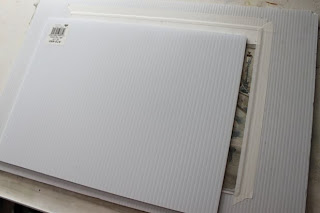 This post addresses two questions I hear often--whether it is necessary to pre-stretch the paper for a watercolor painting, and how to flatten a painting that is buckled or warped.
This post addresses two questions I hear often--whether it is necessary to pre-stretch the paper for a watercolor painting, and how to flatten a painting that is buckled or warped.I don't stretch the paper before painting. One reason is that I have very limited time for painting, and this preparatory step would consume some of that time. Secondly, I often paint outdoors, and it would be impractical to carry several boards with stretched paper. Finally, I don't really find it necessary.
As the photo above illustrates, I simply clip the sheet corners to the board and that works well for my purposes.
While clipping the sheet to the board keeps the paper flat while I'm painting, sometimes the sheet warps after I take the clips off, and I need to flatten it. I'll use my latest painting to illustrate the process, as in the photo below.

1. First, I wet the back of the painting thoroughly with a flat brush and clean water. I spread the water evenly on the entire surface.

2. As show in the photo, I allow the paper to absorb the water evenly until saturated, and add more water in some spots if I notice they are drying too rapidly (I live in Colorado and the air is very dry).

3. I wait until dampness is down to a sheen, and turn the paper over, to be face up, onto a clean, dry board. I place another board over the painting and press it down to make sure it's flat.

4.I move the board to expose one edge of the sheet at a time, and tape that edge down with masking tape. I press and flatten the tape well to avoid any gaps or bubles. I repeat until all edges are taped.

5.I remove the board from the top and let the painting dry, laying horizontally, face up, uncovered, until it's completely dry and stretched. This could take many hours, so I often leave it to dry overnight.

6.Finally, I remove the tape carefully to avoid tearing or damage to the paper, and the painting is now completely flat.



This is exactly what I do and it works fine for me too. It is important to be careful when removing the tape: I've torn the edges of a few paintings when I've been careless.
ReplyDeleteHi Keith, you are right, it used to happen to me sometimes when I used 3M tan tape. Now I use Intertape white masking tape and it has good adhesion and does not tear the paper. I always pull the tape at a 90 degree angle, that works better.
ReplyDeleteNote: I use mostly Fabriano Artistico (as in both examples in the post) and Arches Cold Press 140lb paper, and the techniques described work well with both.
ReplyDeleteHi Marcio,
ReplyDeleteI was googling for how to flatten paper art and came across your excellent blog! Hope you are doing well. I recently purchased the art of a somewhat famous local artist and didn't want to botch it up. He works in many different mediums so I probably won't attempt this on his work. This will, however, help with flattening my intaglio prints, which can be a challenge sometime too. Thanks for the advice.
Best regards,
Jon Lybrook